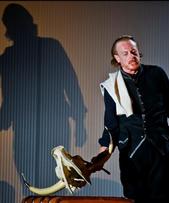SITE GUIDE
SEARCH
REVIEWS
REVIEW ARCHIVES
ADVERTISING AT CURTAINUP
FEATURES
NEWS
Etcetera and
Short Term Listings
LISTINGS
Broadway
Off-Broadway
NYC Restaurants
BOOKS and CDs
OTHER PLACES
Berkshires
London
California
New Jersey
DC
Connecticut
Philadelphia
Elsewhere
QUOTES
TKTS
PLAYWRIGHTS' ALBUMS
LETTERS TO EDITOR
FILM
LINKS
MISCELLANEOUS
Free Updates
Masthead
Writing for Us
A CurtainUp  London Review
London Review
 London Review
London ReviewThe Marriage of Figaro
|
I start to understand what it is to be a husband. — Figaro
|

Iain Robertson as Figaro (Photo: Sarah Lee) |
For Mozart’s The Marriage of Figaro Irish actress Fiona Shaw shows her astonishing directorial talent and gets some fine performances from her cast. This is the third opera that Miss Shaw has directed for the ENO but her first Mozart.
Of course the English translation will never please purists but Jeremy Sams’ translation is very fine and largely avoids the clunky words we associate with clumsy operatic translations, exaggerated and underlined when sung repeatedly. The diction of the singing is also very distinct.
I may argue with some of Miss Shaw’s concept in designing her Figaro within a Minotaur maze littered with bull skulls and horns. For those looking for the horns/cuckold connection, it is not really there as the sexual dalliance between Susanna (Devon Guthrie) and the Count (Roland Wood) after her marriage to Figaro (Iain Paterson) is avoided and neither do the Countess (Elizabeth Lllewelyn) and the page Cherubino (Kathryn Rudge) indulge, except in his declaring a passion for her.
What the white walled maze does do is to convey a large mansion with activity in every room and when the stage revolves we see the behind the scenes activity, including armies of servants cleaning shoes and churning milk for cheese. There is the hustle and bustle of a large house in the preparations for the marriage of a servant of the house.
We are told in the programme that Miss Shaw wanted to use the legend of Theseus defeating the Minotaur with the help of Ariadne who is eventually abandoned by Theseus on the island of Naxos. I am having trouble working out who is who in relation to the Greek myth. Figaro is Theseus, the Count is the Minotaur, is Ariadne Susanna or the Countess?
The plot of Figaro is very convoluted with certainly as many twists and dead ends as a maze but Miss Shaw’s production has a clarity which conveys the essence of what we need to know to follow most of the story. The subplot with Marcellina (Lucy Schaufer) wanting to marry Figaro is thankfully resolved when he is revealed to be her son.
Kathryn Rudge as the sweet page boy Cherubino strides across the stage leaning backwards in a mock show of male bravado which is really funny when he has to wear a dress to escape the notice of the Count. I found Figaro and the Count’s treatment of Cherubino quite brutal when he is forcibly shaved and then a sword is menacingly placed between his thighs, maybe Shaw’s comment on this masculine ruled society. Unluckily for Kate Valentine, who was due to play The Countess until a chest infection struck her down hours before the press opening, Elizabeth Llewelyn takes over the role and is perfect. No-one could have guessed that she was understudying except that of course the director was not able to rehearse her performance at such short notice and we can only speculate what might have been. Iain Paterson’s Figaro has stage presence and a clear voice.
Steven Williams has created some video shadows projected on the back wall of the set - Mozart contemporaries bowing to each other, stately and atmospheric. The design is firmly Spanish and maybe also about bull fighting with those black rimmed Spanish aristocratic hats like in the advertisements for sherry! The stage is littered with symbolic props, a giant toothed, iron mantrap and the projected swirling hat pin later used to identify the letter to the Count as being from Susanna.
Paul Daniel conducts the orchestra and Mozart’s well known music is beautiful rendered. Fiona Shaw’s production has excellent singing and a satisfying theatricality.
|
Subscribe to our FREE email updates with a note from editor Elyse Sommer about additions to the website -- with main page hot links to the latest features posted at our numerous locations. To subscribe,
E-mail: esommer@curtainup.comesommer@curtainup.com
put SUBSCRIBE CURTAINUP EMAIL UPDATE in the subject line and your full name and email address in the body of the message -- if you can spare a minute, tell us how you came to CurtainUp and from what part of the country. |
| The Marriage of Figaro
Music by Wolfgang Amadeus Mozart Libretto by Lorenzo da Ponte after Pierre-Augustin Caron de Beaumarchais’ play English translation by Jeremy Sams Directed by Fiona Shaw Conductor: Paul Daniel Starring: Roland Wood, (Kate Valentine) Elizabeth Lllewelyn, Devon Guthrie, Ian Paterson, Kathryn Rudge, Lucy Schaufer, Jonathan Best, Timothy Robinson, Alun Rhys-Jenkins, Martin Lamb. Mary Bevan With: Ella Kirkpatrick, Lydia Marchione, Daniel Hay-Gordon, Tim Lamford, Anna Martine, Magnus McCullagh, Carl Patrick, Paul Smethurst, Genny Vascotto, Emma Vickery Leader: Janice Graham Chorus Master: Nicholas Chalmers Designer: Peter McKintosh Lighting: Jean Kalman Video Designer: Steven Williams Movement Director: Kim Brandstrup Running time: Three hours 20 minutes with one interval Box Office: 0871 911 0200 Booking to 10th November 2011 Reviewed by Lizzie Loveridge based on 5th October 2011 performance at The London Coliseum, St Martin’s Lane, London WC2N 4ES (Tube: Leicester Square) |
|
REVIEW FEEDBACK Highlight one of the responses below and click "copy" or"CTRL+C"
Paste the highlighted text into the subject line (CTRL+ V): Feel free to add detailed comments in the body of the email . . . also the names and emails of any friends to whom you'd like us to forward a copy of this review. |
|
London Theatre Tickets Lion King Tickets Billy Elliot Tickets Mighty Boosh Tickets Mamma Mia Tickets We Will Rock You Tickets Theatre Tickets |




